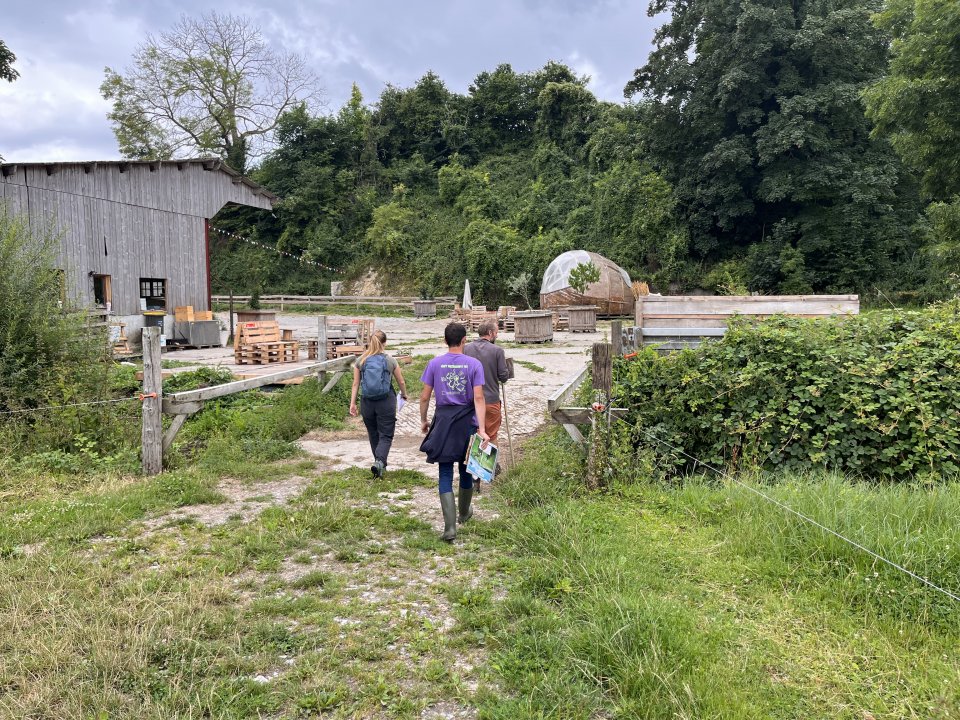
At the western end of the Pays de Bray in Seine-Maritime, the Ferme du Temple covers 180 hectares being converted to agrosilvopastoralism. Part of the land is organically farmed as pasture and to produce hay for the dairy herd. The second part is given over to a crop rotation including wheat, barley, oilseed rape, peas, spelt, broad beans, and occasionally flax, buckwheat and hemp (conversion completed in 2020). The plots are bordered by a Natura 2000 site to the west and south, and a natural area of ecological, faunistic and floristic interest (ZNIEFF II) to the north and south. The 70 cows are grass-fed all year round, using a plot of land organised around the milking parlour. In 2021, the farmer opened a mobile run for 80 laying hens on the pastures of the Ferme du Temple. The system he has developed conserves pastureland and enhances the landscape by lining paths and plots with a variety of hedges. The agri-environmental and climatic measure (MAEC) of late-mowing is applied to 15 hectares of meadows, and 45 hectares of field crops will eventually be reconverted to meadowland. A third activity involves receiving tourists at the farm, mainly cyclists who travel along the « Avenue Verte » Paris-London cycle route. Festivities are organised every year in June, bringing together the local producers associated with Gautier Fihue’s farm (livestock farmer, beekeeper, brewer).
- For adapting to climate change : mitigating the effects of climate change, creating microclimates and stabilising forage yields.
- For biodiversity : creating ecological continuity between the various areas of high ecological interest and developing a fodder system favourable to biodiversity.
- For the local area : creating developments using a landscape approach, which is a symbolic, heritage issue in the area, and integrating them into local supply chains.
Begun in 2017, the works consisted in :
- Planting 5 350 trees and shrubs, including 3 000 high branch trees and shrubs in hedges and 339 intra-plot agroforestry saplings in the first year.
- Planting three more intra-plot rows of 470 ml the following year to divide a 25-hectare plot into three future grazing and cereal-growing areas (10-year rotation).
- In 2020, planting 800 plants taken from willow, ash and alder cuttings in flood meadows.
BENEFITS REGARDING TARGETED ADAPTATION ISSUES
- Improving the resistance of the farming system to climatic hazards by protecting plots of land and livestock against increasingly frequent and intense droughts and high temperatures.
OTHER BENEFITS
- Diversification of activity through tourism is underway.
- The technical and reception buildings will be heated by a biomass boiler fuelled by the residues from hedgerow maintenance.
BENEFITS FOR BIODIVERSITY
- Enabling the return of farmland birds and small birds of prey.
- Strengthening the green network by means of new ecological corridors.
- Creating refuges for beneficial organisms and birdlife.
- Improving soil quality and water infiltration.
- Protecting grazing animals.
- Developing climate change adaptation; improving risk management and resilience
- Reduce drought risk
- Reduce risk of damages from drought
- Reducing temperature at meso or micro scale
- Increase Biodiversity
- Increase well-being
TECHNICAL ASPECTS AND PROJECT DESIGN
- Protecting the seedlings : the main threat to the agroforestry plot is grazing by deer. The project leader therefore plans to set up a 2-metre-high 5-wire fence.
STAKEHOLDER COMMITMENT
- Sharing knowledge : the farmer has set up the « Au Mont Blanc Normand » association, organising a 4km nature trail with information panels.
- Building a network : the farmer, a brewer, a honey producer, a baker, a vegetable grower and producers of ice cream, made with milk from the farm, have set up a direct sales network in which they also exchange techniques.
MONITORING AND REPLICABILITY OF THE ACTION
- Monitoring plantings : around 5 % of the trees had to be replanted, depending on the row. The beech and pedunculate oak trees suffered particularly badly from the hot weather in 2022, so it was decided not to replant these species.
- Row maintenance : every year, 2 people spend 3 days clearing, 15 students from Saint Joseph’s High School in Mesnières en Bray spend 2 days pruning and 9 of them spend an extra day on shaping.
- Continuity : the farm is continuing to develop agroforestry at a rate of around 2 000 ml per year in partnership with the forestry school of Saint Joseph’s High School in Mesnières en Bray. As a director of the Normandy Rural Agricultural Initiatives Centre (CIVAM) since 2022, the farmer has noted a growing interest in agroforestry in the region.
CDC Biodiversité Nature 2050 Programme : 16 650
€ Total budget : 16 650 €
Plus the cost of sustaining and monitoring the project until 2050, to be covered by the Ferme du Temple and CDC Biodiversité.
Further information
Gautier Fihue nature2050@cdc-biodiversite.fr
Nature 2050 – Programme & Fonds
nature2050@cdc-biodiversite.fr
- 2. Zero Hunger
- 13. Climate Action
- 15. Life On Land
